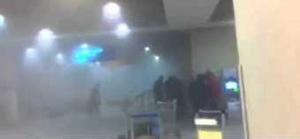Behavioral observationUnited States susceptible to Moscow-style bombing
The TSA has invested $212 million to train hundreds of Behavioral Detection Officers (BDOs) in the Screening of Passengers by Observation Techniques (SPOT) program; the program is supposed to train security personnel to notice suspicious behavior by people in crowds, but lawmakers and academics question its value

Video capture of the immediate aftermath of explosion // Source: jalopnik.com
In wake of the Moscow airport bombing that left thirty-five dead, U.S. lawmakers and academics are criticizing an expensive security program deemed “vital” by the TSA. The ability of the 5-year old, $212 million SPOT program, created to educate airport personnel to notice suspicious behavior, to prevent a Moscow-style bombing is being questioned. Behavioral Detection Officers (BDOs) working for the Screening of Passengers by Observation Techniques (SPOT) program, and stationed in a number of U.S. airports, have made 1,700 arrests of people who were deemed suspicious, but none of the arrests has resulted in an indictment for terrorism.
According to an ABC news report, chairman of the House Transportation Committee, Rep. John Mica (R-Florida), voiced his concern after the attack in Moscow: “I honestly don’t believe that we could detect in advance this type of event.” This is not the first time Mica has voiced his opposition to the program (“Efficacy of TSA’s behavioral threat detection program questioned” 24 May 2010 HSNW).
Dr. Maria Hartwig, an assistant professor at John Jay College of Criminal Justice in New York and an expert in the psychology of deception and its detection, says that there is no scientific support for ensuring that the SPOT program actually works.
Much of the program’s tenets have been based on the work of Dr. Ekman, a retired psychology professor at the University of California who claims that the GAO’s report which questioned the value of SPOT was “more critical than it had to be.” Ekman also said that the major problem is not the program, but the funding, since SPOT officers only attend approximately four days of classes analyzing micro-expressions, variants of the seven universal facial expressions. Unlike Ekman’s anthropological and psychological predecessors, Ekman worked to prove that facial expressions of emotions were not culturally determined. In an experiment titled the Wizards Project, Ekman worked alongside Maureen O’Sullivan of the University of San Francisco and found that from a group of 20,000 people, 50 “naturals” or “Truth Wizards” had the ability to discern facial deceptions without formal training.
The BBC offers a quiz based on Ekman’s teachings called “Spot the Fake Smile.” The reader is quizzed on their ability to evaluate whether or not they can discern genuine smiles from fake ones. They are subsequently offered a short explanation of the exercise involving the Facial Action Coding System (FACS) as developed by Ekman and Dr. Wallace V. Friesen of the University of Kentucky.
